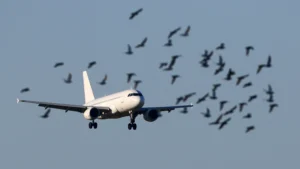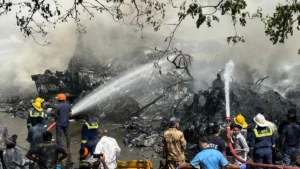On June 12, 2025, the vibrant city of Ahmedabad, India, was plunged into mourning when Air India Flight AI171, a Boeing 787-8 Dreamliner bound for London’s Gatwick Airport, crashed just 32 seconds after takeoff from Sardar Vallabhbhai Patel International Airport. The plane, carrying 242 passengers and crew, slammed into a medical hostel in the Meghaninagar neighborhood, unleashing a fireball that claimed 241 lives aboard and at least 24 on the ground. Only one passenger, Vishwash Kumar Ramesh, seated in 11A, survived, while his brother Ajay, in 11J, perished. As investigators sift through the wreckage, a chilling theory has emerged: a collision with a flock of birds may have crippled the plane’s engines, sending it plummeting into one of India’s deadliest aviation disasters. This possibility, coupled with stories of loss and miraculous escapes, has left the world reeling.
A Flight Cut Short
Flight AI171 was a tapestry of dreams, carrying 169 Indian nationals, 53 British citizens, seven Portuguese, and one Canadian. Among them were Pratik Joshi, a software engineer, his wife Dr. Komi Vyas, and their three children, who had secured visas after a six-year struggle to reunite in London; former Gujarat Chief Minister Vijay Rupani; and young cabin crew members from Manipur. The aircraft, a 12-year-old Boeing 787-8 registered as VT-ANB, was piloted by Captain Sumeet Sabharwal and First Officer Clive Kundar, both seasoned aviators. At 1:38 p.m. local time, it lifted off runway 23 under clear skies, its GE Aerospace GEnx-1B engines roaring for a nine-hour journey.
But at 625 feet, a loud bang reverberated through the cabin, followed by a frantic “Mayday” call signaling a catastrophic failure. Videos captured the plane’s nose pitched upward, landing gear extended, and flaps possibly retracted, as it struggled to climb. It veered and crashed into the BJ Medical College hostel, a residence for doctors and students, igniting 125,000 liters of fuel in a massive explosion. The tail, lodged in the hostel’s ruins, became a global symbol of tragedy, with debris scattered across 200 meters.
The Bird Strike Hypothesis
As rescue operations transitioned to investigation, India’s Aircraft Accident Investigation Bureau (AAIB), joined by the U.S. National Transportation Safety Board and Britain’s Air Accidents Investigation Branch, recovered the Flight Data Recorder, offering hope for answers. The Cockpit Voice Recorder remains missing, buried in the debris. Early findings point to a possible double engine failure, a rare event that could explain the plane’s inability to climb. A leading theory, gaining traction among experts, is a bird strike—a collision with a flock of birds that may have been sucked into both engines, causing them to lose power.

Ahmedabad’s airport, located near urban areas, is notorious for bird activity. Gujarat reported 462 bird strike incidents over five years, with Ahmedabad accounting for the majority, including 38 in 2022–23, a 35% increase from the previous year. The airport’s efforts to control bird populations, through measures like habitat management, had reduced incidents in 2024, but the risk persists. Experts note that a flock of birds, possibly kites or pigeons common in the area, could have overwhelmed the engines during the critical takeoff phase, when the plane was at its most vulnerable. The “Mayday” call, reporting “no thrust” and a “lack of power,” supports this theory, suggesting a sudden, simultaneous failure that left the pilots with no time to react.
Other possibilities, such as flap misconfiguration or fuel contamination, are under review, but the bird strike theory aligns with the plane’s low altitude and the airport’s history. The Boeing 787, designed to fly on one engine, would require a rare double failure to crash so swiftly, making birds a plausible culprit. GE Aerospace has dispatched a team to assist, while Boeing, facing its first fatal Dreamliner crash, pledges full cooperation.
A Tapestry of Loss and Survival
The crash’s human toll is staggering. Of the 242 aboard, only Vishwash Kumar Ramesh survived, seated in 11A near an emergency exit. The seat’s position by the wing’s structural spar and a door allowed him to escape the inferno. Bloodied and limping, he emerged from the wreckage, later recounting a loud bang and waking amid bodies. “I kept calling for Ajay, but I couldn’t find him,” he said from Ahmedabad Civil Hospital, where he was treated for bruises and impact injuries. His brother, Ajay, in 11J across the aisle, perished, a loss that haunts Vishwash as he recovers physically but grapples with emotional scars.
The Joshi family—Pratik, Komi, and their children Miraya, Nakul, and Pradyut—were among the 241 fatalities. Their viral selfie, captioned “Our new beginning,” captured their joy minutes before the crash, now a heart-wrenching symbol of dreams destroyed. In Banswara, Rajasthan, their relatives mourn, their home filled with untouched suitcases packed for London. Other victims included cabin crew members like Roshni Rajendra Songhare, a travel influencer, and students at the hostel, where the plane’s nose struck the canteen, killing at least five during lunch.
Bhoomi Chauhan, a 32-year-old from Bharuch, narrowly escaped the tragedy. A traffic jam delayed her by 10 minutes, causing her to miss the flight. Learning of the crash at the airport, she credited Lord Ganesha, clutching a small idol from her mother. “I was angry about the traffic, but it was God’s plan,” she said, her relief tempered by grief for those lost.

A Nation’s Response
India united in sorrow. Prime Minister Narendra Modi visited the crash site, meeting Vishwash and consoling families. Home Minister Amit Shah and Civil Aviation Minister Ram Mohan Naidu coordinated rescue efforts, with over 290 bodies recovered, many requiring DNA testing. Air India offered ₹1 crore (about $116,000) per victim’s family and established support centers in Ahmedabad, Mumbai, Delhi, and Gatwick. The airline suspended operations at Ahmedabad airport, its social media darkened in mourning.
Globally, leaders expressed solidarity. U.S. President Donald Trump pledged investigative aid, while British Prime Minister Keir Starmer and King Charles III mourned the 53 British victims. The crash’s scale, the deadliest since Malaysia Airlines Flight 17 in 2014, has drawn scrutiny to aviation safety in India, a fast-growing market. The hostel’s proximity to the runway has sparked calls for stricter zoning, as urban sprawl heightens risks.
Implications and Reflections
The bird strike theory, if confirmed, would underscore the need for enhanced wildlife management at Indian airports. Ahmedabad’s high bird strike rate, second only to Delhi despite fewer flights, highlights a persistent challenge. Past incidents, like a 2021 Dreamliner aborting takeoff in Mexico due to birds, show the threat’s severity. The crash, the first fatal incident for the Boeing 787, has shaken confidence in a model prized for reliability, raising questions about Air India’s maintenance and Boeing’s oversight.
Online, the tragedy resonates deeply. Social media posts mourn the Joshi family’s selfie and Vishwash’s survival, while marveling at Chauhan’s escape. Users share prayers and images of the crash site, calling for better safety measures. The contrast between seat 11A’s miracle and 11J’s tragedy fuels reflections on fate, with Vishwash’s pleas for Ajay echoing across platforms.
A City’s Resilience
Ahmedabad, scarred but resilient, honors its victims while celebrating its survivors. Vishwash, recovering in hospital, embodies hope amid despair, his survival a testament to chance and structural fortune. Chauhan, preparing to fly to London, carries gratitude for her second chance. The Joshi family’s loss, like that of countless others, leaves a void, their selfie a reminder of life’s fragility.
As investigators analyze the black box, the bird strike theory looms large, a potential key to unlocking the disaster’s cause. Whether birds, mechanical failure, or human error doomed Flight AI171, the world seeks answers to prevent such heartbreak. For now, Ahmedabad mourns, its skies quieter but its spirit unbroken, as stories of miracles and tragedies weave a tapestry of human endurance.





